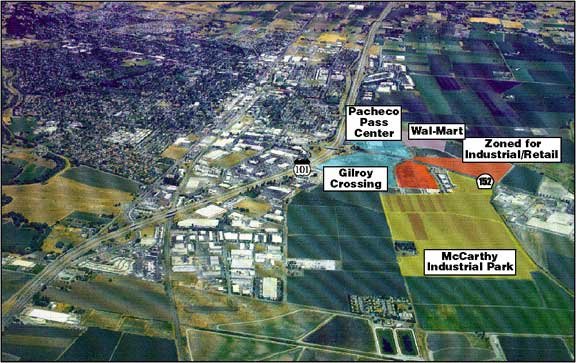GILROY
– The interchange of U.S. 101 and state Highway 152 is a major
crossroads for Californians traveling north-south between the Bay
Area and the southern part of the state.
GILROY – The interchange of U.S. 101 and state Highway 152 is a major crossroads for Californians traveling north-south between the Bay Area and the southern part of the state. Soon it will also be a commercial crossroads, as dozens of stores open by next year at two new shopping centers, banking on travelers and regional residents stopping to shop and eat.
The new Gilroy Crossing and Pacheco Pass centers have 23 confirmed tenants – nearly all chains – which include Kohl’s department store, Best Buy electronics, Barnes & Noble bookstore, Michaels arts and crafts, Marshall’s clothing, Sportsmart, PETsMART and at least five sit-down restaurants. A huge Lowe’s Home Improvement, Costco and Target have already opened, and – most controversial of all – Wal-Mart plans to close its Arroyo Circle store and build a Supercenter there, which would include a full-service supermarket. Of these, only Wal-Mart is still waiting on city government approval.
After these, the centers will still have room for another 25 or so smaller businesses. All told, the plan is for 1.4 million square feet of new retail space. Then, east of the Pacheco Pass Center, there’s more undeveloped land zoned for retail or industry.
This is a bonanza for services like police, fire and public works, since the city takes a penny in tax for every dollar spent on non-food items.
Bill Lindsteadt, executive director of the Gilroy Economic Development Corp., expects the shopping centers as a whole to turn over about $400 million in taxable sales a year, which means an annual $4 million boost to the city’s general fund. Curently, the city gets about $11 million in sales taxes from all other businesses combined.
They also offer Gilroyans and anyone willing to drive here a wealth of new places to shop.
For existing local merchants, however, they’re something to worry about.
Construction of the Wize Owl Bookstore & Gifts was under way about a year ago when owner Michele Campbell found out about Barnes & Noble. She knew then she was out on a limb. Daunting competition was on the way, and she had already signed her lease.
At present, there’s no other general bookstore like Wize Owl in Gilroy. There’s a outlet store for bargain-priced books from publishers’ clearance sales, one for Christian reading and a student store at Gavilan College, but nowhere else where, if you know what title you want, you can be reasonably sure they’ll either have it or can order it.
Barnes & Noble, however, will be a huge dose of just that. Campbell says she’s ready for it, and her aggressive, creative efforts to highlight Wize Owl’s unique character, show community spirit and, thereby, secure customer loyalty may very well pay off despite the giant across town. Wize Owl donates money and books to local organizations, features local authors, takes part in community events like the Gilroy Garlic Festival and holds its own free events: children’s story readings, book signings and demonstrations of cooking and fashion.
“Yes, we’re concerned, but we feel that independent bookstores can hold their own,” Campbell said. “We (pride) ourselves in our customer service and special orders. … The chains have volume as their thing.”
To vie for consumers’ dollars with the new mega-merchants, many, like Wize Owl, will fight to distinguish themselves from the chains. Many will survive; some may go under.
That’s business, Lindsteadt says.
“This country was built on free enterprise,” Lindsteadt said Wednesday, as he’s said many times before. “You can’t hold someone out just because of competition.”
The grocery market is expected to heat up the most, both according to Lindsteadt and the tumult of talk in recent City Council campaigns. Target and Costco are already selling some groceries, but the big threat to Gilroy’s Nob Hill, Safeway and P.W. Market Place supermarkets will be the Wal-Mart Supercenter.
The combination of these would “obviously” cut into business at P.W. Market Place on nearby Tenth Street, P.W. Senior Vice President and Chief Operating Officer Michael Stigers said Thursday from the small chain’s headquarters in Alum Rock.
“At this time, we’ll continue to operate and put our best foot forward,” Stigers said.
Wal-Mart is the world’s largest retailer and the nation’s biggest private employer. Its characteristic low prices are fueled partly by its immense buying power. Its $245 billion in recent annual sales is larger than the gross national product of Switzerland, according to the Washington Post, and it influences nearly all the nation’s manufacturing industries.
More notoriously, Wal-Mart’s price scale is also made possible by low, non-union labor costs – 20 to 30 percent lower than those of unionized supermarkets, according to the consulting firm Retail Forward, as quoted in the Post. Since entering the grocery business a decade ago with its Supercenters, Wal-Mart has sold groceries at 15 percent less than the competition, Retail Forward said. For every Supercenter that opens in the next five years, the study concluded, two supermarkets will close; that’s 400 a year in the United States, 2,000 in five.
“An average person visits a grocery store once or twice a week and a retail store once or twice a month,” Stigers, of P.W., said, “so the retail stores are trying to sell groceries to get people in their store (more often).”
Smaller supermarkets like P.W. likely have more to worry about than Nob Hill or Safeway.
“We are up for the challenge,” Nob Hill corporate spokesperson Nicole Townsend said Thursday. “We believe that our superior customer service, quality products and value will keep customers coming to our stores.”
Dave Heylen, vice president of commerce for the California Grocers Association, said Wal-Mart Supercenters present a new aspect to the state grocery market. Gilroy’s Supercenter, if approved, would be one of the state’s first, one of a wave of 40 in the works.
To thrive in a Supercenter’s shadow, grocers would be wise to focus on niche marketing, Heylen said. Some focus on an ethnic group; Gilroy’s Arteaga’s Super Save mostly targets the Hispanic community. Others, like Nob Hill, try to make their customer service go above and beyond the rest, according to Heylen.
“Your traditional grocer, the one who’s aggressive and creative, should be able to survive Wal-Mart coming in, but they’ll have to be on their toes – no doubt about that,” Heylen said.
Together, the new stores will provide as many as 2,800 retail jobs, according to the city’s projection of two employees per 1,000 square feet. There are currently about 2,200 unemployed people living in Gilroy, Lindstead said, but many of them are refugees from high-tech, high-paying fields, unlikely to settle for low-paying retail work. The city umemployment rate was 3 percent before the dot-com bust; now it’s 12 percent, according to Lindsteadt.
Lindsteadt says people will commute here to work, as many do now, from Hollister, Los Banos, Salinas and elsewhere.
“We’re becoming a job center here,” Lindsteadt said.
The 101/152 crossroads is a desirable enough location for retail that developers picked Gilroy over its neighbors despite the fact that Morgan Hill, San Jose and Hollister have city funds reserved for incentive gifts to development. Gilroy doesn’t have this, but it’s not without an incentive package of its own.
To lure companies, the city offers to waivesits hefty development fee – $14 per square foot for retail – which covers the impacts to city streets, sewers and water systems in lieu of sales tax. For a 155,000 square-foot box store like Costco, that’s more than a $3 million bonus. Instead of paying the fee up front, a business – in this case a developer – can pay it with sales taxes generated over the first three years. If it pays the fee off in less than three years, the city puts the remainder in the general fund. If it isn’t paid off in three years, the city bills the business for the rest, plus interest.
While the city won’t collect sales taxes for up to three years, Lindsteadt expects these stores, particularly the larger ones, to be around for many years to come – perhaps two or three decades.
“It’s an investment in the future,” he said of the incentives.














